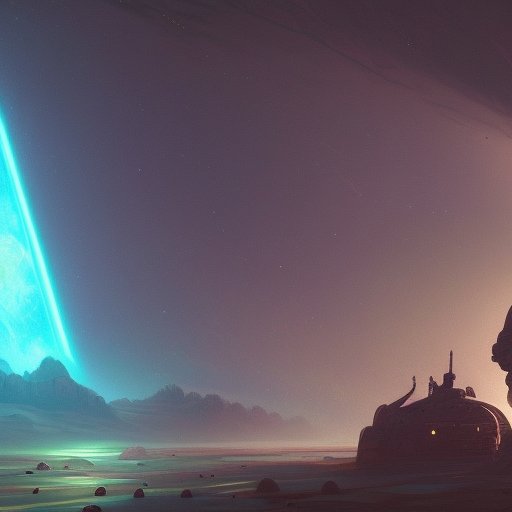
As we venture further into the depths of space, planetary colonization becomes imperative for the survival and prosperity of humanity. The ability to sustain life in a foreign environment requires extensive preparation and strategic planning. This article outlines five major aspects of planetary colonization: preparation, terraforming, sustainability, technology, and exploration. Each section includes recipes tailored to the unique challenges and requirements of space colonization. From nutrient-rich space food to eco-friendly hygiene products, this guide equips future space colonizers with the necessary tools for success. Join us on a journey of wonder and discovery as we explore the possibilities of planetary colonization.
I. Introduction
My fellow interstellar adventurers, today, we embark on a journey of breathtaking magnitude. As our galaxy expands, so too must our reach. It is time for us to take the fate of our species into our own hands and venture forth into the great beyond, soaring among the stars in search of new worlds to inhabit.

Planetary colonization is no mere luxury, but rather a crucial need for our continued survival. Our world is poised on the brink of catastrophe, our resources scarce and our environment threatened. It is up to us to seize this opportunity to forge a new path and secure a future for generations to come.
Make no mistake, dear readers, the challenges we face are nothing short of daunting. We must prepare ourselves for the harsh realities of space, where every breath is a precious commodity and every decision could mean life or death. We must master the art of terraforming, designing living spaces and ecosystems to thrive in worlds that were once desolate and inhospitable.
We must also strive for sustainability, creating self-sustaining colonies that rely on renewable resources and minimally impact their surroundings. And we must harness the power of technology, developing new tools and innovations to overcome the obstacles that lie before us.
But our quest is not simply one of survival; it is a call to adventure and discovery. We stand on the cusp of a new era of exploration, where every planet and every star holds the promise of discovery, of new life and new knowledge. It is a time for bravery, for creativity, and for bold action.
So come with us, dear readers, as we set forth on this grand journey. Together, we will explore the furthest reaches of the cosmos, seeking out new worlds and new experiences. We will face challenges and dangers beyond imagining, but we will also find wonder and beauty beyond compare.
The future is bright, my friends, and it is up to us to seize it. Let us embark on this quest together and make history among the stars.
II. Section I
Before we can plunge headfirst into the depths of the unknown, we must first prepare ourselves for the journey ahead. The rigors of space travel are not to be underestimated, and we must ensure that we are in optimal condition for the trials to come.

One of the most fundamental aspects of space preparation is diet. Eating in space requires a whole new way of thinking, as the traditional methods of food preparation and storage may not survive the journey. Long-term storage and preservation are essential, as is the ability to prepare meals in a microgravity environment.
This is where space-friendly foods come into play. These are meals that can be easily stored, prepared, and consumed in the harsh conditions of outer space. They must be lightweight, nutritionally dense, and simple to prepare. Fortunately, there are many recipes available that satisfy these requirements, while also being delicious and satisfying.
One example of a space-friendly food is pasta. By using dehydrated or freeze-dried noodles, a simple pasta dish can provide a hearty and nutritious meal on long journeys. Another option is protein bars, which offer a quick and easy source of sustained energy.
Fruits and vegetables are also important in space diets, as they provide essential vitamins and nutrients that may be lacking in other foods. Freeze-drying and vacuum sealing can keep these foods fresh for extended periods of time.
It’s important to note that the dietary needs of astronauts and space colonists may differ from those on Earth. The lack of gravity can affect the digestive system, and the effects of radiation and other environmental factors must also be considered.
But fear not, fellow explorers, for we have decades of research and experience to draw upon. By following a carefully crafted diet plan and experimenting with new recipes, we can ensure that our bodies are ready for whatever challenges the cosmos may throw our way. So let’s prepare ourselves for the adventure of a lifetime, one bite at a time.
III. Section II
Fellow space explorers, we must not underestimate the importance of terraforming in our journey towards planetary colonization. Creating a habitable environment on a barren and lifeless planet is no easy feat, but with ingenuity and persistence, we can forge a new home among the stars.

First and foremost, we must examine the atmosphere of our target planet. Is it toxic to humans, or lacking in the necessary gases to sustain life? Fear not, for there are solutions to both of these problems. For toxic atmospheres, consider introducing genetically engineered plants that can convert harmful toxins into breathable air. And for planets lacking in necessary gases, consider atmospheric processors that can extract and store gas from the planet’s crust.
Next, we must examine the planet’s climate. Extreme temperatures, solar radiation, and weather patterns can pose serious challenges to sustained habitation. To combat this, we can use a variety of methods, such as creating artificial magnetic fields or building habitats underground, shielded from the elements.
Once the environment has been modified to support human life, it is important to begin building a functional ecosystem. This means introducing plant life, water sources, and, eventually, animal life to help maintain the planet’s environment and support a balanced food chain.
And of course, let us not forget about our most basic needs—food and sustenance. Creating a sustainable food source on a newly terraformed planet is vital to the success of the colony. Consider genetically modified crops that can thrive in the new environment and provide necessary nutrients for human consumption.
IV. Section III
In order to establish a sustainable colony in space, we must be resourceful and strategic in our practices. This means finding creative ways to minimize waste and pollution, and maximizing our use of renewable resources. We can start by developing sustainable hygiene practices, using alternative cleaning solutions and methods that minimize the use of harmful chemicals.

In terms of resource use, our colony must rely on renewable sources of energy, like solar and wind power, to sustain our energy needs. We can also look to innovative solutions like hydroponic farming, which allows us to grow crops in a controlled environment without the need for soil or pesticides.
But sustainability goes beyond just resource use; it also extends to our living spaces. We must design our colonies with sustainability in mind, using recycled and repurposed materials wherever possible. We can even look to nature for inspiration, taking cues from the way plants and animals adapt to their environments to inform our designs.
To make sustainability a way of life in our colonies, we must also prioritize education and awareness. By teaching people about the importance of sustainability and the impact of our actions, we can create a culture of conservation that will ensure the longevity of our colony.
And of course, sustainability doesn’t have to mean sacrificing style, comfort, or taste. With the right recipes and a little bit of creativity, we can develop sustainable and delicious meals that nourish both our bodies and the planet. From plant-based protein sources to locally-sourced ingredients, we can create a culinary culture that upholds our commitment to sustainability.
With these sustainable practices in place, we can ensure that our colonies remain vibrant and healthy for generations to come. So let us embrace the challenge of sustainability, and in doing so lay the foundation for a bright and sustainable future among the stars.
V. Section IV
Ah, the wonders of technology! In our quest for planetary colonization, we must rely on our knowledge and innovation to build a new world among the stars. But what sort of technological feats must we achieve to create a sustainable colony?

First and foremost, we must develop infrastructure that can withstand the harsh realities of space travel. From the moment of launch, our vessels must be well-equipped to house, feed, and care for our colonizers. Our engineers must be as skilled in the art of gravity control as they are in crafting the most durable alloys of steel and titanium.
Once we reach our destination, we must begin building a colony from scratch. This requires a wide array of technologies, from advanced 3D printing for fabrication to AI-driven pathfinding for efficient construction. Furthermore, it is crucial that our infrastructure be designed with sustainability in mind, incorporating renewable energy sources and minimizing our ecological impact.
Of course, our technological needs do not end there. Maintaining a colony requires a wide array of devices, from air and water filtration systems to advanced medical equipment. And where would we be without our trusty computing technology, necessary for everything from life support to communication with other galaxies?
In the end, our success will depend on our ability to harness the power of technology in innovative and transformative ways. If we can do so, we will create a new world beyond anything humanity has ever seen. We will build towering cities among the stars, with technology so advanced that even our wildest dreams will seem paltry in comparison.
So come, my fellow scientists and engineers, let us create a new world together! Let us work tirelessly to refine our technologies and design our infrastructure with care. If we can do so, we will make history in the annals of space colonization, and secure a new home for humanity among the stars.
VI. Section V
Ah, the final frontier: alien exploration. As we venture forth into the unknown, seeking out new worlds and new civilizations, we must not forget the importance of a good meal. After all, even the most intrepid spaceman can’t survive on nutrient paste and recycled water forever.

So what do we eat when we encounter beings from other worlds? Fear not, my friends, for we have the ultimate guide to space cuisine.
First off, it’s important to note that not all alien food is edible (or friendly, for that matter). We must take care to analyze the alien biology before diving in. But assuming the alien food is safe, what can we expect?
For starters, alien life forms will likely have different nutritional needs and tastes than our own. We might encounter organisms that thrive on radiation or feed on rocks. But never fear – with some creativity and ingenuity, we can craft tasty meals from even the most bizarre of ingredients.
One example of this is the infamous Horta omelette, a delicacy hailing from Starfleet’s adventures in the original Star Trek series. The Horta, a silicon-based life form, was initially thought to be a hostile creature until it was revealed that it was merely guarding its eggs. After making peace with the Horta, the crew of the Enterprise whipped up an omelette made from the Horta’s eggs, cooked in the same manner as Earth’s chickens.
But who says we have to stick to Earthbound recipes? Let’s get creative and embrace the diversity of the universe. How about a Zorgonian stir-fry with crunchy Pangalactic Gargleblaster noodles? Or a N’iiian stew, chock full of protein-rich tentacles and freshly-harvested flora?
The possibilities are endless, my dear readers. So pack your spice racks and prepare for a culinary adventure of epic proportions. Who knows – you might just discover the next great space cuisine sensation.
VII. Conclusion
As our journey through the cosmos draws to a close, it is fitting that we take a moment to reflect on the lessons we have learned and the path that lies ahead. We have seen that colonization is not merely a matter of survival, but of possibility and potential.

We must continue to push the boundaries of what we know, to experiment, and to dream. Every new world we inhabit is an opportunity for growth and discovery, an invitation to explore the miracles of the universe.
But as we strive for greatness, we must also remember the simple pleasures of life. A good meal, a warm bed, a friendly face – these are the things that remind us of our humanity, of our connection to one another and the universe as a whole.
So let us not forget the importance of nourishing both body and soul. Let us continue to develop new culinary delights and innovative means of food production, to create communities that thrive and flourish even in the harshest of worlds.
And let us remember that, as we venture forth into the great unknown, we do so not only for ourselves but for all humankind. Let our quest be not only for our own survival but for the prosperity of future generations, for the preservation of our planet and the explorations of uncharted territories.
In the end, our mission is one of hope, of wonder, and of courage. Let us embrace this spirit as we journey onward, forging a future that is as bright and limitless as the stars themselves.






